CUDA Mode - Fusing Kernels Talk
Performance focussed talk on using torch.compile to generate fused kernels and learning triton along the way
Talk
With focus on performance to get the most out of hardware, fusing of kernels has been a popular technique. At times, researchers/practitioners will re-write their code in native cuda or cpu kernels to get optimal performance, but projects such as torch.compile aim to make this simpler. Talk will focus on generating fused kernels and how to leverage torch.compile to be able to do that. We will work on creating fused kernels (triton and cuda) with the help of torch.compile. Here is the link to the talk:
Overview
This blog post wont describe the talk in detail but will provide a high level structure of the talk. Do not expect a lot of explanations in the post - listen to the talk to follow along.
The talk is structured as follows:
How is the talk structured
- Dive into DLRM (open source deep rec sys model)
- Build it from scrarch
- Go through some paper cuts
- torch.compile
- Writing fused kernels
- Case Study: LoRA
Setup
Code and other artifacts
- Lecture code
- How to open chrome trace:
chrome://tracing - DLRM Blog Post
- DLRM Paper
- DLRM github repo
- Criteo Dataset
- Pytorch Profiler with Tensorboard
- TORCH_LOGS with torch.compile
- LoRA Paper
- LoRA from scratch
- GPUs go brrr
DLRM (Deep Learning Recommendation Model)
MODEL ARCHITECTURE
- Takes a bunch of dense and sparse features
- Dense features feed to a dense MLP layer
- Sparse features feed into embedding layers
- Interaction layers between dense NN layers and spares embeddings combine dense and sparse outputs
- Interaction “features” output prediction click/no-click as output from an MLP
System Constrants
- D Dense Features MLP output
- S Sparse Features
- E Embedding Dimension on average
Interaction: $O((D \cdot S \cdot E) ^ 2)$
Criteo Dataset
- Training dataset with 24 days of ad display and click data (positive: clicked and negatives: non-clicked)
- 13 features taking integer values (mostly count features)
- 26 anonymized categorical features
- Corresponding Kaggle competition: https://www.kaggle.com/c/criteo-display-ad-challenge
Exploring DLRM
Next, we explore the DLRM model and build it from scratch. We will go through the model architecture and build the model in PyTorch. We will also go through the Criteo dataset and run a batch through our model.
Data Loader
1
2
3
4
5
6
7
8
9
10
11
12
13
14
15
16
17
18
19
20
21
22
23
24
25
26
27
28
29
30
31
import json
import time
from dataclasses import dataclass
from typing import Mapping, List, Dict, Union
import click
import torch
import torch._dynamo
from loguru import logger
from torch import nn, Tensor
from torch.utils.data import DataLoader
from criteo_dataset import CriteoParquetDataset
from model import DenseArch, read_metadata, SparseArch, DenseSparseInteractionLayer, PredictionLayer, Parameters, DLRM
file_path = "/assets/data/sample_criteo_data.parquet"
metadata_path = "/assets/data/sample_criteo_metadata.json"
logger.info("Reading the parquet file {}...".format(file_path))
logger.info("Reading the metadata file {}...".format(metadata_path))
dataset = CriteoParquetDataset(file_path)
data_loader = DataLoader(dataset, batch_size=2, shuffle=False)
labels, dense, sparse = next(iter(data_loader))
logger.info("Labels size: {}".format(labels.size()))
logger.info("Dense size: {}".format(dense.size()))
logger.info("Sparse size: {}".format(sparse.size()))
print(dense)
print(sparse)
1
2
3
4
5
6
7
8
9
10
11
12
13
14
15
16
17
18
19
20
21
22
23
2024-05-11 14:08:50.248 | INFO | __main__:<module>:1 - Reading the parquet file /assets/data/sample_criteo_data.parquet...
2024-05-11 14:08:50.248 | INFO | __main__:<module>:2 - Reading the metadata file /assets/data/sample_criteo_metadata.json...
2024-05-11 14:08:51.393 | INFO | __main__:<module>:7 - Labels size: torch.Size([2])
2024-05-11 14:08:51.394 | INFO | __main__:<module>:8 - Dense size: torch.Size([2, 13])
2024-05-11 14:08:51.394 | INFO | __main__:<module>:9 - Sparse size: torch.Size([2, 26])
tensor([[5.0000e+00, 1.1000e+02, 0.0000e+00, 1.6000e+01, 0.0000e+00, 1.0000e+00,
0.0000e+00, 1.4000e+01, 7.0000e+00, 1.0000e+00, 0.0000e+00, 3.0600e+02,
0.0000e+00],
[3.2000e+01, 3.0000e+00, 5.0000e+00, 0.0000e+00, 1.0000e+00, 0.0000e+00,
0.0000e+00, 6.1000e+01, 5.0000e+00, 0.0000e+00, 1.0000e+00, 3.1570e+03,
5.0000e+00]])
tensor([[1651969401, 3793706328, 2951365679, 2489089999, 951068488, 1875733963,
897624609, 679512323, 1189011366, 771915201, 209470001, 2509774111,
12976055, 3192841527, 2316006604, 1289502458, 3523761834, 3088518074,
2501034507, 3280875304, 351689309, 632402057, 3619814411, 2091868316,
809724924, 3977271069],
[3857972621, 2695561126, 1873417685, 3666490401, 1020698403, 1875733963,
2870406529, 1128426537, 502653268, 2112471209, 1716706404, 2582335015,
12976055, 3192841527, 4089183897, 1289502458, 3523761834, 2716538129,
2501034507, 4273985635, 2737978529, 3370249814, 391309800, 1966410890,
2568167914, 3075991895]])
Dense Layer
Dense features are passed through a dense MLP layer.
1
2
3
4
5
6
7
8
dense_mlp_out_size = 16
num_dense_features = dense.size()[1]
dense_arch = DenseArch(dense_feature_count=num_dense_features,
dense_hidden_layers_sizes=[32],
output_size=dense_mlp_out_size)
dense_out = dense_arch(dense)
logger.info("Dense out size: {}".format(dense_out.size()))
dense_out
1
2
3
4
5
6
7
8
9
2024-05-11 14:08:51.416 | INFO | __main__:<module>:7 - Dense out size: torch.Size([2, 16])
tensor([[ 11.6451, 3.0189, -48.5918, -32.3807, -55.1242, -52.7222,
14.9740, 4.7447, -41.9140, 33.3978, 18.6538, 2.1335,
25.8962, 18.2281, -29.6636, -3.0227],
[ 146.8453, 13.4556, -391.1624, -245.9999, -422.9316, -344.2513,
188.1155, 73.1228, -326.0069, 204.1690, 256.8700, -5.2064,
201.7352, 31.4574, -243.0708, -97.3927]],
grad_fn=<AddmmBackward0>)
Sparse Layer
Sparse features are passed through embedding layers.
1
2
3
4
5
6
7
8
9
10
11
12
metadata = read_metadata(metadata_path)
embedding_size = 16
embedding_sizes = {fn: embedding_size for fn in metadata.keys()}
sparse_mlp_out_size = 16
sparse_arch = SparseArch(metadata=metadata,
embedding_sizes=embedding_sizes)
# compiled model hangs on running with inputs
# sparse_arch_optim = torch.compile(sparse_arch)
sparse_out = sparse_arch(sparse)
for v in sparse_out:
logger.info("Sparse out size: {}".format(v.size()))
sparse_out[0]
1
2
3
4
5
6
7
8
9
10
11
12
13
14
15
16
17
18
19
20
21
22
23
24
25
26
27
28
29
30
31
32
33
2024-05-11 14:08:53.235 | INFO | __main__:<module>:11 - Sparse out size: torch.Size([2, 16])
2024-05-11 14:08:53.236 | INFO | __main__:<module>:11 - Sparse out size: torch.Size([2, 16])
2024-05-11 14:08:53.236 | INFO | __main__:<module>:11 - Sparse out size: torch.Size([2, 16])
2024-05-11 14:08:53.237 | INFO | __main__:<module>:11 - Sparse out size: torch.Size([2, 16])
2024-05-11 14:08:53.237 | INFO | __main__:<module>:11 - Sparse out size: torch.Size([2, 16])
2024-05-11 14:08:53.237 | INFO | __main__:<module>:11 - Sparse out size: torch.Size([2, 16])
2024-05-11 14:08:53.238 | INFO | __main__:<module>:11 - Sparse out size: torch.Size([2, 16])
2024-05-11 14:08:53.238 | INFO | __main__:<module>:11 - Sparse out size: torch.Size([2, 16])
2024-05-11 14:08:53.239 | INFO | __main__:<module>:11 - Sparse out size: torch.Size([2, 16])
2024-05-11 14:08:53.240 | INFO | __main__:<module>:11 - Sparse out size: torch.Size([2, 16])
2024-05-11 14:08:53.240 | INFO | __main__:<module>:11 - Sparse out size: torch.Size([2, 16])
2024-05-11 14:08:53.240 | INFO | __main__:<module>:11 - Sparse out size: torch.Size([2, 16])
2024-05-11 14:08:53.241 | INFO | __main__:<module>:11 - Sparse out size: torch.Size([2, 16])
2024-05-11 14:08:53.241 | INFO | __main__:<module>:11 - Sparse out size: torch.Size([2, 16])
2024-05-11 14:08:53.242 | INFO | __main__:<module>:11 - Sparse out size: torch.Size([2, 16])
2024-05-11 14:08:53.242 | INFO | __main__:<module>:11 - Sparse out size: torch.Size([2, 16])
2024-05-11 14:08:53.242 | INFO | __main__:<module>:11 - Sparse out size: torch.Size([2, 16])
2024-05-11 14:08:53.243 | INFO | __main__:<module>:11 - Sparse out size: torch.Size([2, 16])
2024-05-11 14:08:53.243 | INFO | __main__:<module>:11 - Sparse out size: torch.Size([2, 16])
2024-05-11 14:08:53.243 | INFO | __main__:<module>:11 - Sparse out size: torch.Size([2, 16])
2024-05-11 14:08:53.244 | INFO | __main__:<module>:11 - Sparse out size: torch.Size([2, 16])
2024-05-11 14:08:53.244 | INFO | __main__:<module>:11 - Sparse out size: torch.Size([2, 16])
2024-05-11 14:08:53.245 | INFO | __main__:<module>:11 - Sparse out size: torch.Size([2, 16])
2024-05-11 14:08:53.245 | INFO | __main__:<module>:11 - Sparse out size: torch.Size([2, 16])
2024-05-11 14:08:53.245 | INFO | __main__:<module>:11 - Sparse out size: torch.Size([2, 16])
2024-05-11 14:08:53.246 | INFO | __main__:<module>:11 - Sparse out size: torch.Size([2, 16])
tensor([[-2.0452, 0.7938, -0.0607, -1.4266, 0.2772, 0.9912, -0.3738, 0.4863,
0.6430, 0.3728, -0.6082, -1.2793, -0.7943, 0.5326, 0.8906, 0.1647],
[-0.5692, 0.4912, 1.3526, -1.4923, -1.5862, -0.2653, -0.0764, -0.3848,
0.1008, 1.2955, -1.6488, 1.4038, -1.6606, -2.0017, -0.7786, 0.1461]],
grad_fn=<EmbeddingBackward0>)
Interaction Layer
Dense and sparse features are combined in the interaction layer.
1
2
3
4
dense_sparse_interaction_layer = DenseSparseInteractionLayer()
ds_out = dense_sparse_interaction_layer(dense_out, sparse_out)
logger.info("Dense sparse interaction out size: {}".format(ds_out.size()))
ds_out
1
2
3
4
5
6
2024-05-11 14:08:53.253 | INFO | __main__:<module>:3 - Dense sparse interaction out size: torch.Size([2, 186624])
tensor([[ 1.3561e+02, 3.5155e+01, -5.6586e+02, ..., 7.5871e-01,
-1.5478e-01, 5.0601e-01],
[ 2.1564e+04, 1.9759e+03, -5.7440e+04, ..., -7.6579e-02,
2.4089e-01, 5.5938e-01]], grad_fn=<ViewBackward0>)
Prediction Layer
In prediction layer, we take the output from the interaction layer and pass it through a dense MLP layer and a sigmoid activation function to get the final prediction.
1
2
3
4
5
6
prediction_layer = PredictionLayer(dense_out_size=dense_mlp_out_size,
sparse_out_sizes=[sparse_mlp_out_size] * len(metadata),
hidden_sizes=[16])
pred_out = prediction_layer(ds_out)
logger.info("Prediction out size: {}".format(pred_out.size()))
logger.info("Prediction out value: {}".format(pred_out))
1
2
3
2024-05-11 14:08:53.284 | INFO | __main__:<module>:5 - Prediction out size: torch.Size([2, 1])
2024-05-11 14:08:53.285 | INFO | __main__:<module>:6 - Prediction out value: tensor([[0.2761],
[1.0000]], grad_fn=<SigmoidBackward0>)
Model Graph
ONNX Model Export
Profiling
Initial Setup: Simple 2 layered MLP used for each triangle
Baseline
1
python model_train.py --config ./model_hyperparameters_small.json
Initial Distribution - Naive Implementation of index_hash
1
2
3
4
5
6
7
8
9
...
# mapping loaded as is from the metadata - so a python list
self.mapping = [metadata[f"SPARSE_{i}"]["tokenizer_values"] for i in range(self.num_sparse_features)]
...
# in forward
tokenizers = torch.tensor(tokenizer_values).reshape(1, -1)
if input_tensor.is_cuda:
tokenizers = tokenizers.cuda()
...
Pytorch Profiler trace (initial)
Using tensorboard for high level info
1
tensorboard --logdir tb_logs --bind_all
Initial distribution of ops - summary from tensorboard
Tensor.item() takes a lot of running time
- What’s going on - what is _local_scalar_dense and why is item() taking so long?
- https://discuss.pytorch.org/t/tensor-item-takes-a-lot-of-running-time/16683
- https://discuss.pytorch.org/t/calling-loss-item-is-very-slow/99774
CUDA_LAUNCH_BLOCKING=1 python model_train.py
After passing CUDA_LAUNCH_BLOCKING=1
1
CUDA_LAUNCH_BLOCKING=1 python model_train.py --config ./model_hyperparameters_small.json
New distribution of ops after CUDA_LAUNCH_BLOCKING=1
model_hyperparameters_initial.1714869603606159866.pt.trace.json
 Profile initial index hash implementation
Profile initial index hash implementation
_forward_index_hashis taking a lot of time
Improvements
1
2
3
4
5
6
# in ctor - Put metadata needed for model directly on the gpu
self.mapping = [torch.tensor(metadata[f"SPARSE_{i}"]["tokenizer_values"], device=device) for i in
range(self.num_sparse_features)]
# in forward - dont use reshape if you can avoid
tokenizers = tokenizer_values.view(1, -1)
Profile after improvements
What’s next
- Index hash seems pretty expensive
- Can we improve/simplify the hash function/tokenization
- Let’s just calculate the modulus hash based on cardinality
- Maybe not representative of data if distribution is non uniform across categories (but that’s fine for now)
Using Modulus Hash
1
2
def modulus_hash(tensor: torch.Tensor, cardinality: torch.Tensor):
return (tensor + 1) % cardinality
Pytorch Profiler trace for optimized modulus hash
Hashing is not the bottleneck anymore
torch.compile DLRM
1
2
TORCH_COMPILE_DEBUG_DIR=/home/ksharma/logs TORCH_LOGS=recompiles,+dynamo,inductor,guards,graph_breaks python model.py
CUDA_LAUNCH_BLOCKING=1 python model_train.py
- GPU utilization goes up
- memory footprint goes down
Memory Footprint
Pre torch.compile
Post torch.compile
Chrome Trace after torch.compile
Pytorch Profile Trace after torch.compile
Let’s look deeper into what’s going on
Custom triton kernel scheduled on the cuda stream
Increase complexity
Source: DLRM BLog
python dlrm_s_pytorch.py --arch-sparse-feature-size=16 --arch-mlp-bot="13-512-256-64-16" --arch-mlp-top="512-256-1" --data-generation=dataset --data-set=kaggle --processed-data-file=./input/kaggle_processed.npz --loss-function=bce --round-targets=True --learning-rate=0.1 --mini-batch-size=128 --print-freq=1024 --print-time
Let’s change the model architecture
- –arch-mlp-bot=”13-512-256-64-16”
- –arch-mlp-top=”512-256-1”
Eager view
- Sparse Arch is now not the biggest piece of the pie
- PredictionLayer is the highest
- Top MLP and sigmoid
torch.compile view
Generate triton code
How do we see what is going on with the triton kernels?
To generate triton code for compiled model, we can use the following command:
1
TORCH_LOGS=output_code CUDA_LAUNCH_BLOCKING=1 python model_train.py --config ./model_hyperparameters_main.json --use_torch_compile
Inspect
- Prints generated code for you
- Should see
... torch._inductor.graph.__output_code: [INFO] Output code written to: ... - Shows source nodes from where the code was generated
- Fused kernels:
- fused_relu
- fused_cat
- fused_embedding
- fused_sigmoid_squeeze
- Reinterpret_tensor: https://github.com/pytorch/pytorch/blob/ca98c2a932132e49559bf777c02798633d585e66/torch/csrc/inductor/inductor_ops.cpp#L54
Write our own
Annotated Triton Kernel
1
2
3
4
5
6
7
8
9
10
11
12
13
14
15
16
17
18
19
20
21
22
23
24
25
26
27
28
29
30
@triton.jit
def pointwise_add_relu_fusion_512(in_out_ptr0, in_ptr0, XBLOCK : tl.constexpr):
# Number of elements in in_out_ptr0 (B X N)
xnumel = 65536
# This program will process inputs that are offset from the initial data.
# For instance, if you had a strided tensor of 65536 i.e. 128 X 512 and XBLOCK = 512
# the programs will each access the elements [0:512, 512:1024, ...].
# i.e. offsets is a list of pointers:
# Question: Can you see how torch.compile is allocating blocks here?
# below we will call this N = 512
xoffset = tl.program_id(0) * XBLOCK
# block threads
xindex = xoffset + tl.arange(0, XBLOCK)[:]
# masks to guard against overflow
xmask = xindex < xnumel
# xindex will have elements from 0:N, N:2N where N = dense @ weights
x2 = xindex
# bias i.e. 1D tensor with only N elements
# mod will give the us the right
x0 = xindex % 512
# load the N elements
tmp0 = tl.load(in_out_ptr0 + (x2), xmask)
# load the 1D tensor
tmp1 = tl.load(in_ptr0 + (x0), xmask, eviction_policy='evict_last')
# result = bias + dense @ weights
tmp2 = tmp0 + tmp1
# relu: can also use tl.maximum
tmp3 = triton_helpers.maximum(0, tmp2)
# output moved over
tl.store(in_out_ptr0 + (x2), tmp3, None)
Test
1
2
3
4
5
6
7
8
9
10
11
12
13
14
15
16
17
18
19
20
21
22
23
24
25
26
27
28
29
30
31
32
33
34
import triton
import torch
import triton.language as tl
from torch._inductor import triton_helpers
from torch._inductor.triton_heuristics import grid
@triton.jit
def pointwise_add_relu_fusion_512(in_out_ptr0, in_ptr0, XBLOCK : tl.constexpr):
xnumel = 65536
xoffset = tl.program_id(0) * XBLOCK
xindex = xoffset + tl.arange(0, XBLOCK)[:]
xmask = xindex < xnumel
# dense @ weights
x2 = xindex
# bias
x0 = xindex % 512
tmp0 = tl.load(in_out_ptr0 + (x2), xmask)
tmp1 = tl.load(in_ptr0 + (x0), xmask, eviction_policy='evict_last')
# bias + dense @ weights
tmp2 = tmp0 + tmp1
tmp3 = triton_helpers.maximum(0, tmp2)
tl.store(in_out_ptr0 + (x2), tmp3, None)
torch.cuda.set_device(0) # no-op to ensure context
X = torch.ones(size=(128, 512), device='cuda')
print(X[:3, :3])
Y = torch.ones(size=(512,), device='cuda')
print(Y[:3])
eager_result = torch.maximum(X + Y, torch.tensor(0., device='cuda'))
print(eager_result[:3, :3])
pointwise_add_relu_fusion_512[grid(65536)](X, Y, 512)
print(X)
torch.testing.assert_close(X, eager_result, rtol=1e-4, atol=1e-4)
1
2
3
4
5
6
7
8
9
10
11
12
13
14
tensor([[1., 1., 1.],
[1., 1., 1.],
[1., 1., 1.]], device='cuda:0')
tensor([1., 1., 1.], device='cuda:0')
tensor([[2., 2., 2.],
[2., 2., 2.],
[2., 2., 2.]], device='cuda:0')
tensor([[2., 2., 2., ..., 2., 2., 2.],
[2., 2., 2., ..., 2., 2., 2.],
[2., 2., 2., ..., 2., 2., 2.],
...,
[2., 2., 2., ..., 2., 2., 2.],
[2., 2., 2., ..., 2., 2., 2.],
[2., 2., 2., ..., 2., 2., 2.]], device='cuda:0')
Cuda Kernel
Ask ChatGPT to generate the kernel for us
ChatGPT output (without any changes)
1
2
3
4
5
6
7
8
9
10
11
12
13
14
15
16
17
18
19
20
21
22
#include <cuda_fp16.h>
__global__ void pointwise_add_relu_fusion_512(float* in_out_ptr0, const float* in_ptr0, const int XBLOCK) {
const int xnumel = 65536;
const int N = 512; // Value of N from the Triton kernel
const int tid = threadIdx.x;
const int xoffset = blockIdx.x * XBLOCK;
const int xindex = xoffset + tid;
const bool xmask = xindex < xnumel;
if (xmask) {
int x2 = xindex;
int x0 = xindex % N;
float tmp0 = in_out_ptr0[x2];
float tmp1 = in_ptr0[x0];
float tmp2 = tmp0 + tmp1;
float tmp3 = max(0.0f, tmp2); // ReLU operation
in_out_ptr0[x2] = tmp3;
}
}
Let’s run the generated CUDA kernel
NOTE: To run torch native, you can download it as below or add conda environment to $CMAKE_PREFIX_PATH
1
wget https://download.pytorch.org/libtorch/cu121/libtorch-cxx11-abi-shared-with-deps-2.2.1%2Bcu121.zip # Download torch native lib
Build the cmake project
1
mkdir -p kernels/cmake-build-debug && cd kernels/cmake-build-debug && cmake .. -G Ninja && ninja
1
2
3
4
5
6
7
8
9
10
11
12
13
14
15
-- CMake version: 3.22.1
-- Caffe2: CUDA detected: 12.1
-- Caffe2: CUDA nvcc is: /home/ksharma/anaconda3/envs/cuda-learn/bin/nvcc
-- Caffe2: CUDA toolkit directory: /home/ksharma/anaconda3/envs/cuda-learn
-- Caffe2: Header version is: 12.1
-- /home/ksharma/anaconda3/envs/cuda-learn/lib/libnvrtc.so shorthash is c993a6f1
-- USE_CUDNN is set to 0. Compiling without cuDNN support
-- USE_CUSPARSELT is set to 0. Compiling without cuSPARSELt support
-- Autodetected CUDA architecture(s): 7.5
-- Added CUDA NVCC flags for: -gencode;arch=compute_75,code=sm_75
-- Configuring done
-- Generating done
-- Build files have been written to: /home/ksharma/dev/git/cuda-mode-lecture/kernels/cmake-build-debug
...
1
./kernels/cmake-build-debug/dlrm_kernels_test
1
2
3
4
5
6
7
8
9
10
11
12
13
14
15
16
17
18
19
20
21
22
23
24
25
26
27
28
29
30
31
32
33
34
35
36
37
38
39
40
41
42
43
Tensor x:
-0.9247 -0.4253 -2.6438 0.1452 -0.1209 -0.5797 -0.6229 -0.3284 -1.0745 -0.3631
-1.6711 2.2655 0.3117 -0.1842 1.2866 1.1820 -0.1271 1.2169 1.4353 1.0605
-0.4941 -1.4244 -0.7244 -1.2973 0.0697 -0.0074 1.8969 0.6878 -0.0779 -0.8373
1.3506 -0.2879 -0.5965 -0.3283 -0.9086 -0.8059 -0.7407 -0.0504 0.5435 1.5150
0.0141 0.4532 1.6349 0.7124 -0.1806 1.0252 -1.4622 -0.7554 -0.1836 0.3824
0.3918 -0.0830 0.8971 -1.1123 0.1116 0.4863 -0.5499 -0.3231 -0.5469 0.9049
0.2837 0.1210 0.4730 -1.0823 -0.0334 -0.9734 0.9559 -1.1795 -1.0064 0.1160
0.6852 -0.4124 -0.6738 -0.5404 0.6898 -1.5517 0.3805 -0.0436 0.3597 -0.5043
[ CUDAFloatType{8,10} ]
Tensor y:
0.1808
-0.5523
0.9238
-0.7350
1.3800
0.8676
0.1297
-0.9406
0.8109
0.8821
[ CUDAFloatType{10} ]
Expected:
0.0000 0.0000 0.0000 0.0000 1.2591 0.2879 0.0000 0.0000 0.0000 0.5189
0.0000 1.7132 1.2355 0.0000 2.6666 2.0496 0.0026 0.2763 2.2462 1.9425
0.0000 0.0000 0.1994 0.0000 1.4497 0.8602 2.0266 0.0000 0.7330 0.0448
1.5315 0.0000 0.3273 0.0000 0.4714 0.0617 0.0000 0.0000 1.3544 2.3971
0.1949 0.0000 2.5587 0.0000 1.1994 1.8929 0.0000 0.0000 0.6273 1.2644
0.5726 0.0000 1.8209 0.0000 1.4916 1.3539 0.0000 0.0000 0.2640 1.7869
0.4645 0.0000 1.3968 0.0000 1.3465 0.0000 1.0856 0.0000 0.0000 0.9980
0.8660 0.0000 0.2500 0.0000 2.0698 0.0000 0.5102 0.0000 1.1706 0.3778
[ CUDAFloatType{8,10} ]
Result:
0.0000 0.0000 0.0000 0.0000 1.2591 0.2879 0.0000 0.0000 0.0000 0.5189
0.0000 1.7132 1.2355 0.0000 2.6666 2.0496 0.0026 0.2763 2.2462 1.9425
0.0000 0.0000 0.1994 0.0000 1.4497 0.8602 2.0266 0.0000 0.7330 0.0448
1.5315 0.0000 0.3273 0.0000 0.4714 0.0617 0.0000 0.0000 1.3544 2.3971
0.1949 0.0000 2.5587 0.0000 1.1994 1.8929 0.0000 0.0000 0.6273 1.2644
0.5726 0.0000 1.8209 0.0000 1.4916 1.3539 0.0000 0.0000 0.2640 1.7869
0.4645 0.0000 1.3968 0.0000 1.3465 0.0000 1.0856 0.0000 0.0000 0.9980
0.8660 0.0000 0.2500 0.0000 2.0698 0.0000 0.5102 0.0000 1.1706 0.3778
[ CUDAFloatType{8,10} ]
All Match: true
(OR) Run it locally with pytorch utils
1
2
3
4
5
6
7
8
9
10
11
12
13
14
15
16
17
18
19
20
21
22
23
24
import torch
from torch.utils.cpp_extension import load_inline
cuda_code_file = "./kernels/src/pointwise_add_relu_fused.cu"
header_code_file = "./kernels/src/pointwise_add_relu_fused.cuh"
with open(cuda_code_file) as f:
cuda_code = "".join([f for f in f.readlines() if not f.startswith("#include")])
with open(header_code_file) as f:
header_code = "".join([f for f in f.readlines() if not f.startswith("#include")])
cuda_extension = load_inline(
name='kernel_extension',
cpp_sources=header_code,
cuda_sources=cuda_code,
functions=["add_relu_fusion"],
with_cuda=True,
verbose=True,
extra_cuda_cflags=["-O2"],
build_directory='./build',
)
1
2
3
4
5
6
7
8
9
10
11
12
Detected CUDA files, patching ldflags
Emitting ninja build file ./build/build.ninja...
Building extension module kernel_extension...
Allowing ninja to set a default number of workers... (overridable by setting the environment variable MAX_JOBS=N)
[1/3] c++ -MMD -MF main.o.d -DTORCH_EXTENSION_NAME=kernel_extension -DTORCH_API_INCLUDE_EXTENSION_H -DPYBIND11_COMPILER_TYPE=\"_gcc\" -DPYBIND11_STDLIB=\"_libstdcpp\" -DPYBIND11_BUILD_ABI=\"_cxxabi1011\" -isystem /home/ksharma/anaconda3/envs/cuda-learn/lib/python3.11/site-packages/torch/include -isystem /home/ksharma/anaconda3/envs/cuda-learn/lib/python3.11/site-packages/torch/include/torch/csrc/api/include -isystem /home/ksharma/anaconda3/envs/cuda-learn/lib/python3.11/site-packages/torch/include/TH -isystem /home/ksharma/anaconda3/envs/cuda-learn/lib/python3.11/site-packages/torch/include/THC -isystem /home/ksharma/anaconda3/envs/cuda-learn/include -isystem /home/ksharma/anaconda3/envs/cuda-learn/include/python3.11 -D_GLIBCXX_USE_CXX11_ABI=0 -fPIC -std=c++17 -c /home/ksharma/dev/git/cuda-mode-lecture/build/main.cpp -o main.o
[2/3] /home/ksharma/anaconda3/envs/cuda-learn/bin/nvcc --generate-dependencies-with-compile --dependency-output cuda.cuda.o.d -DTORCH_EXTENSION_NAME=kernel_extension -DTORCH_API_INCLUDE_EXTENSION_H -DPYBIND11_COMPILER_TYPE=\"_gcc\" -DPYBIND11_STDLIB=\"_libstdcpp\" -DPYBIND11_BUILD_ABI=\"_cxxabi1011\" -isystem /home/ksharma/anaconda3/envs/cuda-learn/lib/python3.11/site-packages/torch/include -isystem /home/ksharma/anaconda3/envs/cuda-learn/lib/python3.11/site-packages/torch/include/torch/csrc/api/include -isystem /home/ksharma/anaconda3/envs/cuda-learn/lib/python3.11/site-packages/torch/include/TH -isystem /home/ksharma/anaconda3/envs/cuda-learn/lib/python3.11/site-packages/torch/include/THC -isystem /home/ksharma/anaconda3/envs/cuda-learn/include -isystem /home/ksharma/anaconda3/envs/cuda-learn/include/python3.11 -D_GLIBCXX_USE_CXX11_ABI=0 -D__CUDA_NO_HALF_OPERATORS__ -D__CUDA_NO_HALF_CONVERSIONS__ -D__CUDA_NO_BFLOAT16_CONVERSIONS__ -D__CUDA_NO_HALF2_OPERATORS__ --expt-relaxed-constexpr -gencode=arch=compute_75,code=compute_75 -gencode=arch=compute_75,code=sm_75 --compiler-options '-fPIC' -O2 -std=c++17 -c /home/ksharma/dev/git/cuda-mode-lecture/build/cuda.cu -o cuda.cuda.o
[3/3] c++ main.o cuda.cuda.o -shared -L/home/ksharma/anaconda3/envs/cuda-learn/lib/python3.11/site-packages/torch/lib -lc10 -lc10_cuda -ltorch_cpu -ltorch_cuda -ltorch -ltorch_python -L/home/ksharma/anaconda3/envs/cuda-learn/lib -lcudart -o kernel_extension.so
Loading extension module kernel_extension...
Let’s run the generated extension
1
2
3
4
5
6
torch.cuda.set_device(0) # no-op to ensure context
X = torch.ones(size=(128, 512), device='cuda')
Y = torch.ones(size=(512,), device='cuda')
cuda_extension.add_relu_fusion(X, Y)
print(X)
torch.testing.assert_close(X, eager_result, rtol=1e-4, atol=1e-4)
1
2
3
4
5
6
7
tensor([[2., 2., 2., ..., 2., 2., 2.],
[2., 2., 2., ..., 2., 2., 2.],
[2., 2., 2., ..., 2., 2., 2.],
...,
[2., 2., 2., ..., 2., 2., 2.],
[2., 2., 2., ..., 2., 2., 2.],
[2., 2., 2., ..., 2., 2., 2.]], device='cuda:0')
torch.compile is your triton learning companion : LoRA Fused Kernels
LoRA (LOW-RANK ADAPTATION)
Source: LoRA Paper
- Simple low rank reparametization of weight matrices
- Singular value decomposition
Fused Kernels
1
TORCH_LOGS=output_code CUDA_LAUNCH_BLOCKING=1 python lora_on_simple_mlp.py
[TRITON] Fused Mul Add Relu
1
2
3
4
5
6
7
from lora_on_simple_mlp import *
from kernels.triton_fused_add_mul_relu import *
in_out_tensor, in_tensor, bias = get_inputs(add_manual_seed=True)
expected_output = torch.maximum(in_out_tensor + 0.5 * in_tensor + bias, torch.tensor(0., device='cuda'))
print("Input", in_out_tensor)
print("Expected Output", expected_output)
1
2
3
4
5
6
7
8
9
10
11
12
13
14
15
16
17
18
19
20
21
22
23
24
25
Input tensor([[-0.9247, -0.4253, -2.6438, 0.1452, -0.1209, -0.5797, -0.6229, -0.3284],
[-1.0745, -0.3631, -1.6711, 2.2655, 0.3117, -0.1842, 1.2866, 1.1820],
[-0.1271, 1.2169, 1.4353, 1.0605, -0.4941, -1.4244, -0.7244, -1.2973],
[ 0.0697, -0.0074, 1.8969, 0.6878, -0.0779, -0.8373, 1.3506, -0.2879],
[-0.5965, -0.3283, -0.9086, -0.8059, -0.7407, -0.0504, 0.5435, 1.5150],
[ 0.0141, 0.4532, 1.6349, 0.7124, -0.1806, 1.0252, -1.4622, -0.7554],
[-0.1836, 0.3824, 0.3918, -0.0830, 0.8971, -1.1123, 0.1116, 0.4863],
[-0.5499, -0.3231, -0.5469, 0.9049, 0.2837, 0.1210, 0.4730, -1.0823]],
device='cuda:0')
Expected Output tensor([[1.7098e+00, 0.0000e+00, 0.0000e+00, 0.0000e+00, 6.7049e-01, 0.0000e+00,
3.4424e-01, 1.1223e-02],
[1.8750e+00, 0.0000e+00, 0.0000e+00, 2.2105e+00, 6.6808e-01, 0.0000e+00,
1.8445e+00, 1.9246e+00],
[2.2614e+00, 1.3964e+00, 5.1802e-01, 2.0114e+00, 0.0000e+00, 0.0000e+00,
2.7715e-01, 0.0000e+00],
[2.4750e+00, 0.0000e+00, 1.9079e+00, 5.4869e-01, 3.7923e-01, 0.0000e+00,
3.1791e+00, 6.6843e-01],
[1.8234e+00, 0.0000e+00, 1.1147e-01, 0.0000e+00, 0.0000e+00, 0.0000e+00,
2.4250e+00, 3.2593e+00],
[2.2903e+00, 0.0000e+00, 1.1721e+00, 6.9331e-01, 1.0583e+00, 6.7518e-01,
0.0000e+00, 2.6185e-01],
[1.5804e+00, 0.0000e+00, 9.0740e-01, 1.6670e-01, 5.5230e-02, 0.0000e+00,
1.5325e+00, 3.5984e-01],
[1.5554e+00, 0.0000e+00, 0.0000e+00, 9.4380e-01, 2.9795e-03, 7.4125e-02,
1.6286e+00, 0.0000e+00]], device='cuda:0')
Let’s run sample inputs through the fused kernel and compare against the expected output
1
2
3
4
5
6
7
8
BLOCK_SIZE = 8
grid = lambda meta: (triton.cdiv(in_out_tensor.numel(), meta['BLOCK_SIZE']),)
fused_add_mul_relu[grid](in_out_tensor,
bias,
in_tensor,
in_out_tensor.numel(),
BLOCK_SIZE=BLOCK_SIZE)
torch.testing.assert_close(in_out_tensor, expected_output, rtol=1e-4, atol=1e-4)
Let’s test the cleaner version of the kernel
1
2
3
4
5
6
7
8
9
10
in_out_tensor, in_tensor, bias = get_inputs(add_manual_seed=True)
num_weights = bias.numel()
fused_add_mul_relu_cleaner[grid](in_out_tensor,
bias,
in_tensor,
num_weights,
in_out_tensor.numel(),
multiplier=0.5,
BLOCK_SIZE=BLOCK_SIZE)
torch.testing.assert_close(in_out_tensor, expected_output, rtol=1e-4, atol=1e-4)
[CUDA] Fused Mul Add Relu
As previously, we can generate the cuda kernel for the fused mul add relu kernel using ChatGPT
1
2
3
4
5
6
7
8
9
10
11
12
13
14
15
16
17
18
19
20
21
22
23
24
25
26
27
28
29
30
31
32
33
34
35
36
37
38
39
40
41
__global__ void fused_add_mul_relu_kernel(float *dense_in_out_ptr,
const float *scalar_ptr,
const float *dense_ptr,
const int num_weights,
const int xnumel,
const double multiplier) {
int index = blockIdx.x * blockDim.x + threadIdx.x;
if (index < xnumel) {
int scalar_index = index % num_weights;
float tmp0 = dense_in_out_ptr[index];
float tmp1 = scalar_ptr[scalar_index];
float tmp3 = dense_ptr[index];
float ma_result = max(0.0f, multiplier * tmp3 + tmp0 + tmp1);
dense_in_out_ptr[index] = ma_result;
}
}
torch::Tensor fused_add_mul_relu(torch::Tensor in_out,
const torch::Tensor &bias,
const torch::Tensor &in,
const double multiplier) {
auto numel = in_out.numel();
auto sizes = in_out.sizes();
const int XBLOCK = sizes[0];
dim3 threadsPerBlock(sizes[1]);
dim3 numBlocks((numel + XBLOCK - 1) / XBLOCK);
fused_add_mul_relu_kernel<<<numBlocks, threadsPerBlock>>>(
in_out.data_ptr<float>(),
bias.data_ptr<float>(),
in.data_ptr<float>(),
sizes[1],
numel,
multiplier);
cudaDeviceSynchronize();
return std::move(in_out);
}
torch::Tensor fused_add_mul_relu(torch::Tensor in_out,
const torch::Tensor &bias,
const torch::Tensor &in,
const double multiplier);
We can test the generated cuda kernel using load_inline utility in PyTorch
1
2
3
4
5
6
7
8
9
10
11
12
13
14
15
cuda_extension = load_inline(
name='kernel_extension',
cpp_sources=header_code,
cuda_sources=cuda_code,
functions=["fused_add_mul_relu"],
with_cuda=True,
verbose=True,
extra_cuda_cflags=["-O2"],
build_directory='./build',
)
in_out_tensor, in_tensor, bias = get_inputs(add_manual_seed=True)
num_weights = bias.numel()
result = cuda_extension.fused_add_mul_relu(in_out_tensor, bias, in_tensor, 0.5)
torch.testing.assert_close(result, expected_output, rtol=1e-4, atol=1e-4)
Combine the kernels
Can we use conditionals inside a triton kernel? Sure we can!
Fused add mul sigmoid/relu/etc
Now, the kernel should be able to support an arbitrary activation function
1
2
3
4
5
6
7
8
9
10
11
12
13
14
15
16
17
18
19
20
21
22
@triton.jit
def fused_add_mul_activation_kernel(x_ptr, bias_ptr, in_ptr,
num_weights: tl.constexpr,
xnumel: tl.constexpr,
multiplier: tl.constexpr,
activation: tl.constexpr,
BLOCK_SIZE: tl.constexpr):
xoffset = tl.program_id(0) * BLOCK_SIZE
index = xoffset + tl.arange(0, BLOCK_SIZE)[:]
mask = index < xnumel
bias_index = index % num_weights
tmp0 = tl.load(x_ptr + index, mask)
tmp1 = tl.load(bias_ptr + bias_index, mask, eviction_policy='evict_last')
tmp3 = tl.load(in_ptr + index, mask)
activ_input = multiplier * tmp3 + tmp0 + tmp1
if activation == "sigmoid":
ma_result = tl.sigmoid(activ_input)
elif activation == "relu":
ma_result = tl.maximum(0, activ_input)
# elif ...
tl.store(x_ptr + index, ma_result, mask)
Let’s check the perf of this kernel wrt torch.script, eager torch
We will use the triton benchmark tool to compare the performance of the fused kernel against the eager and torch-scripted version. As part of this exercise, we will look at the FLOPs roof line model to understand the performance of the kernel.
Results from the benchmark
1
2
3
4
5
6
7
8
9
10
batch_size weight_size triton torch torch_scripted
0 4.0 4.0 0.059406 0.020833 0.046875
1 16.0 8.0 0.457143 0.171429 0.475248
2 64.0 16.0 3.000000 1.333333 3.000000
3 256.0 32.0 24.000000 10.484642 24.000000
4 1024.0 64.0 132.485175 69.228170 153.600004
5 4096.0 128.0 558.545450 291.271104 558.545450
6 16384.0 256.0 819.626913 500.115745 833.084721
7 65536.0 512.0 916.320403 306.960193 899.807760
8 262144.0 1024.0 927.003376 306.093989 927.943371
Conclusion
In the final section of the talk, we discussed mega-fused kernels and tradeoffs of performance with reusability. There were other discussions on torch.compile with dynamic shape. I will recommend listening to the talk fully to get the most out of this post.
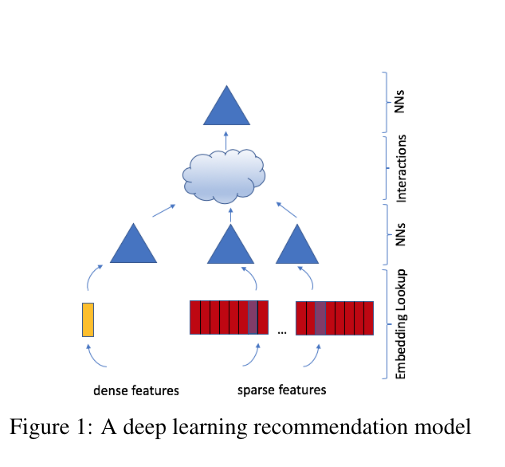

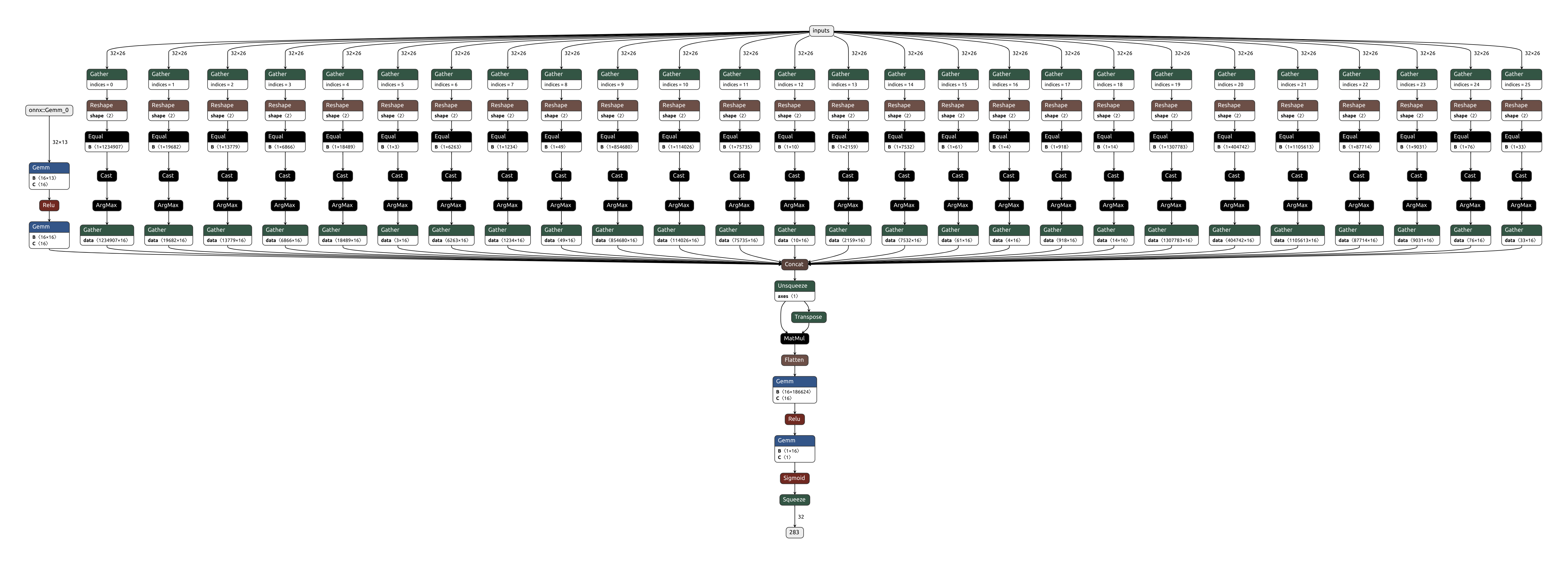


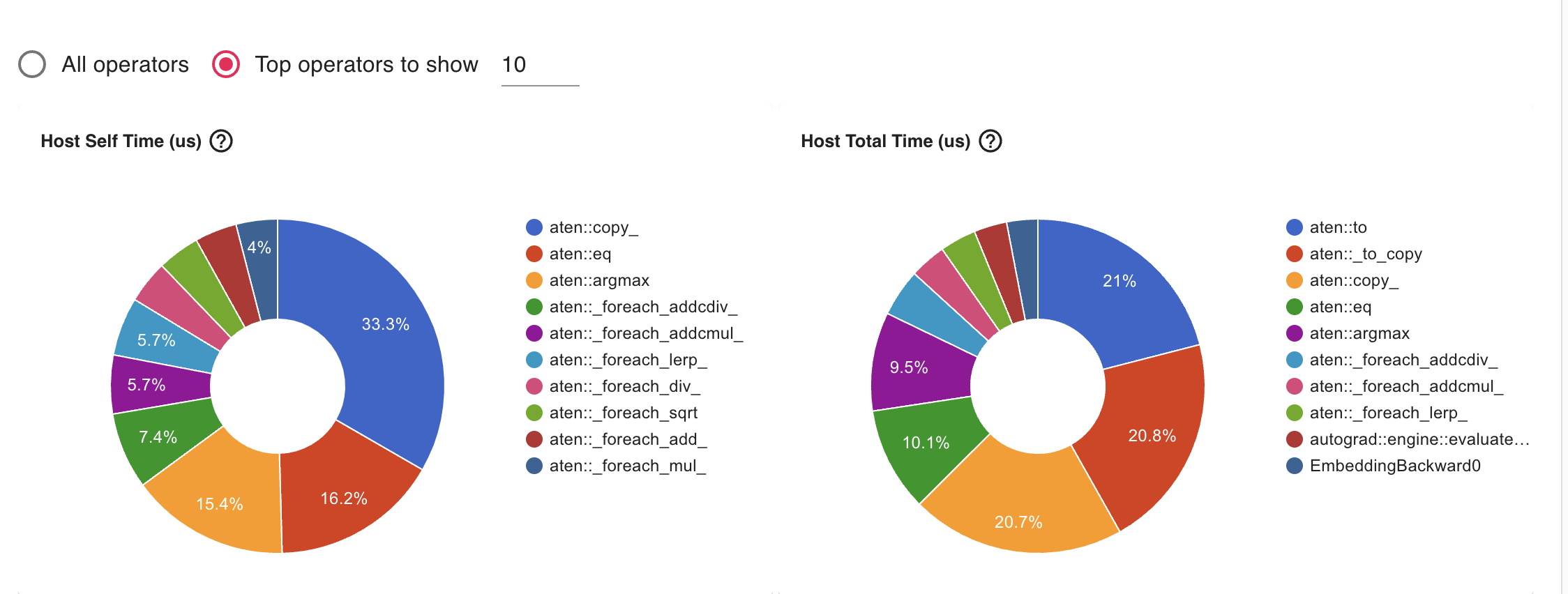


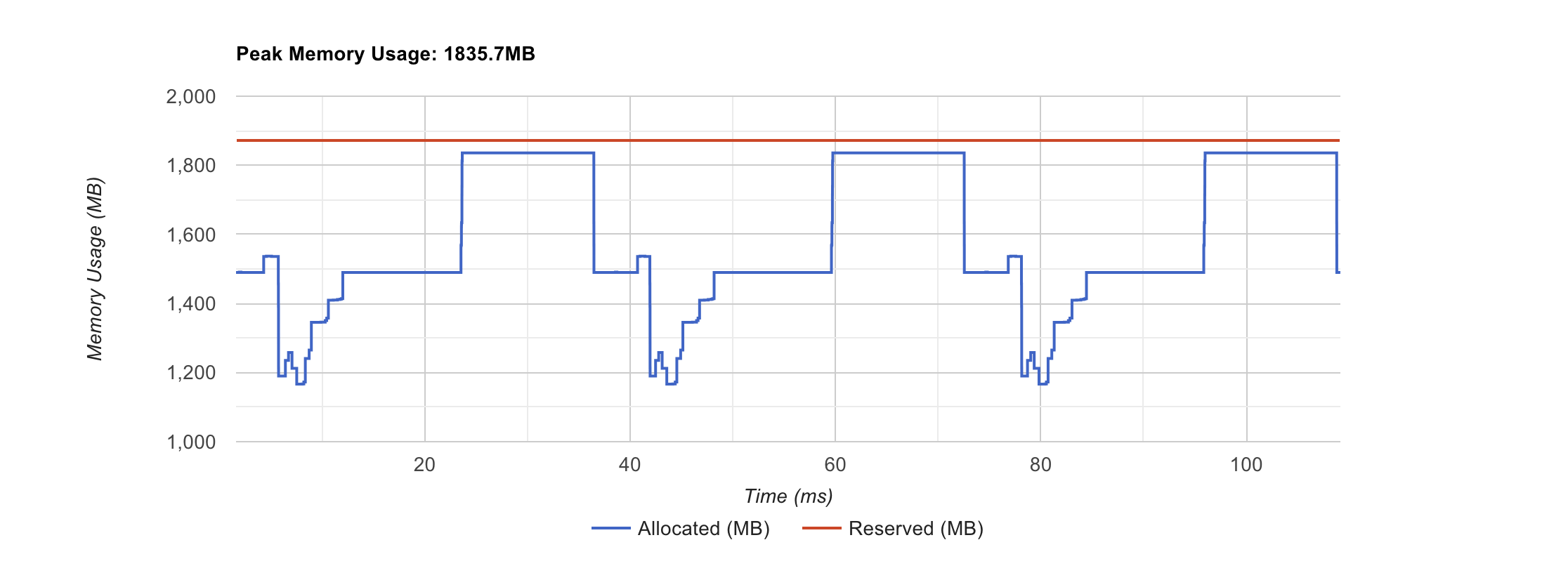
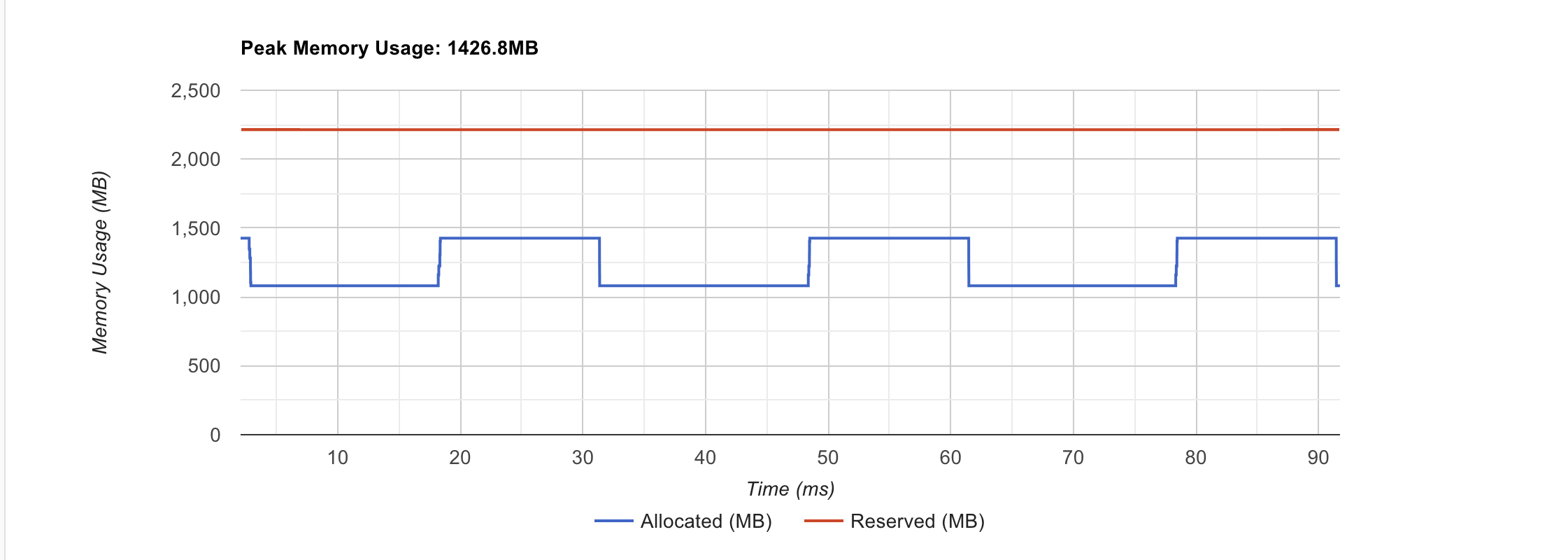
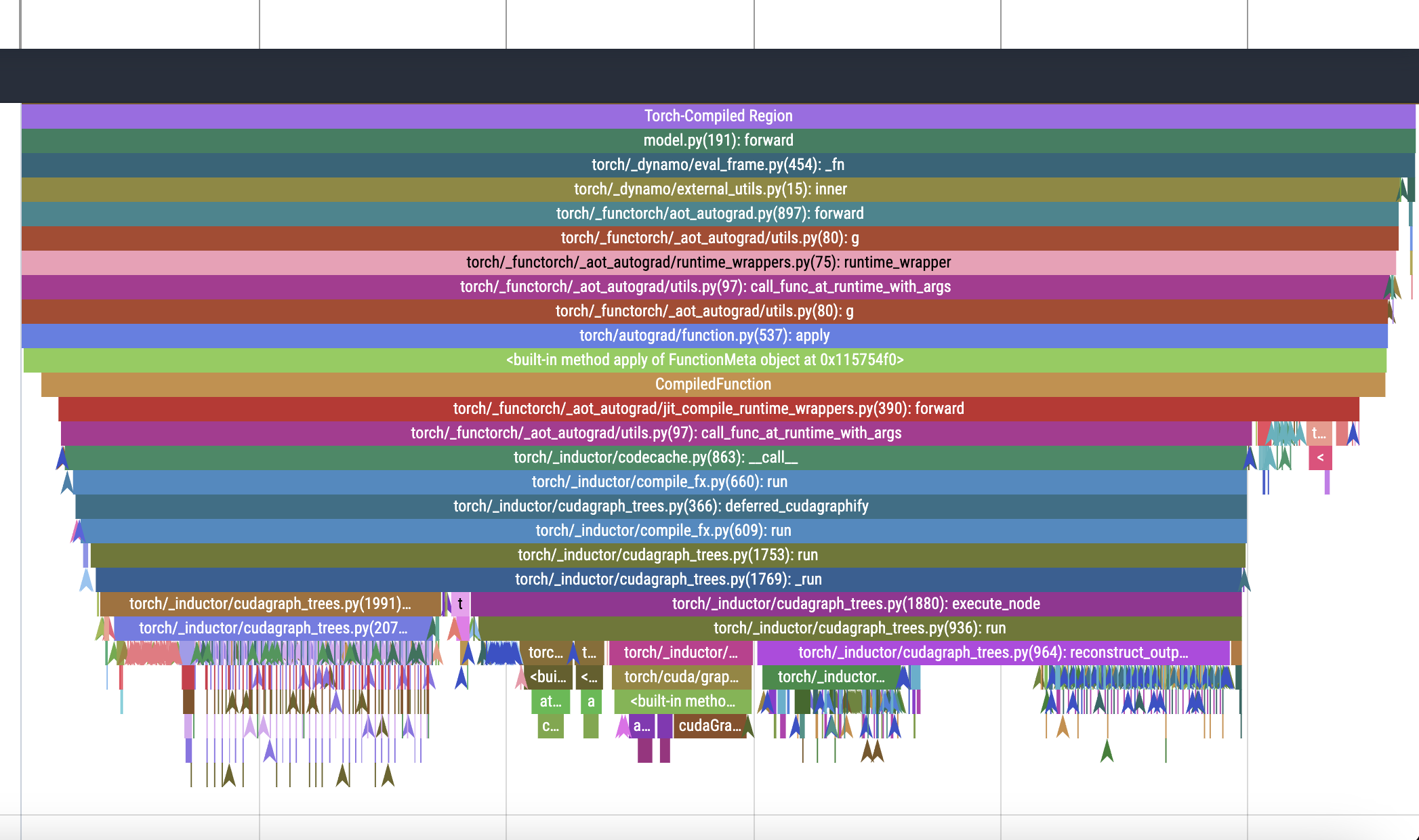

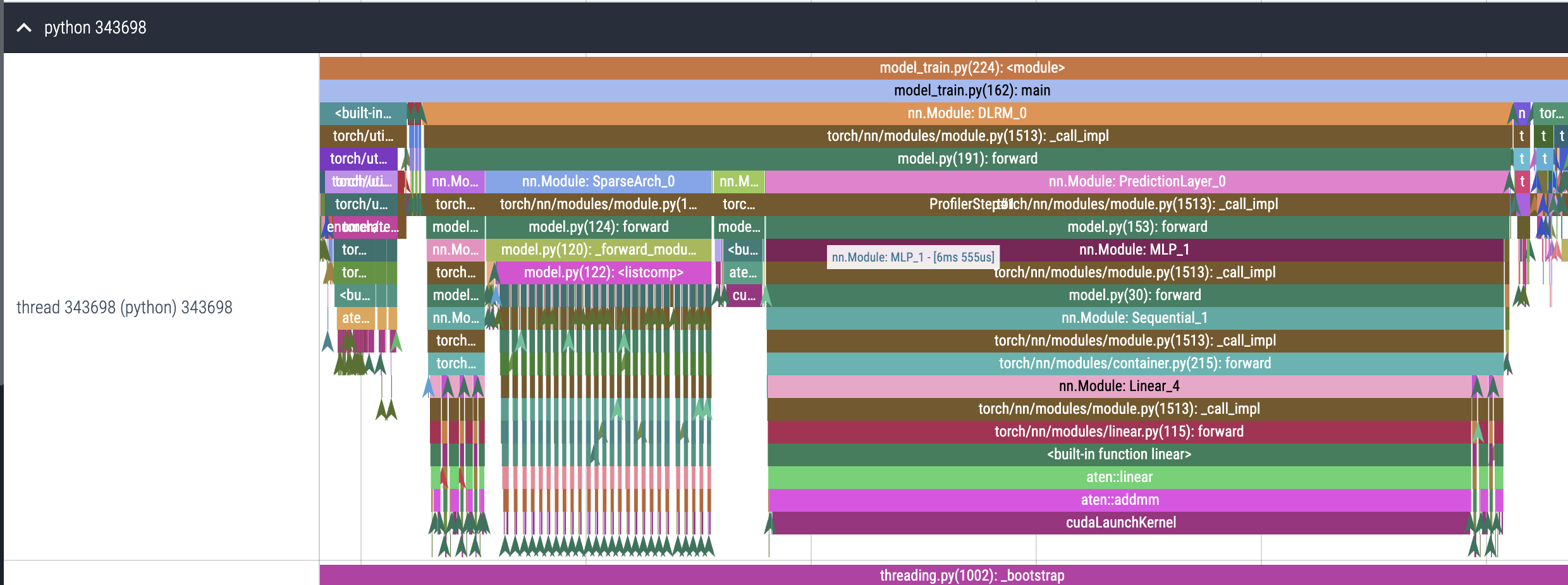
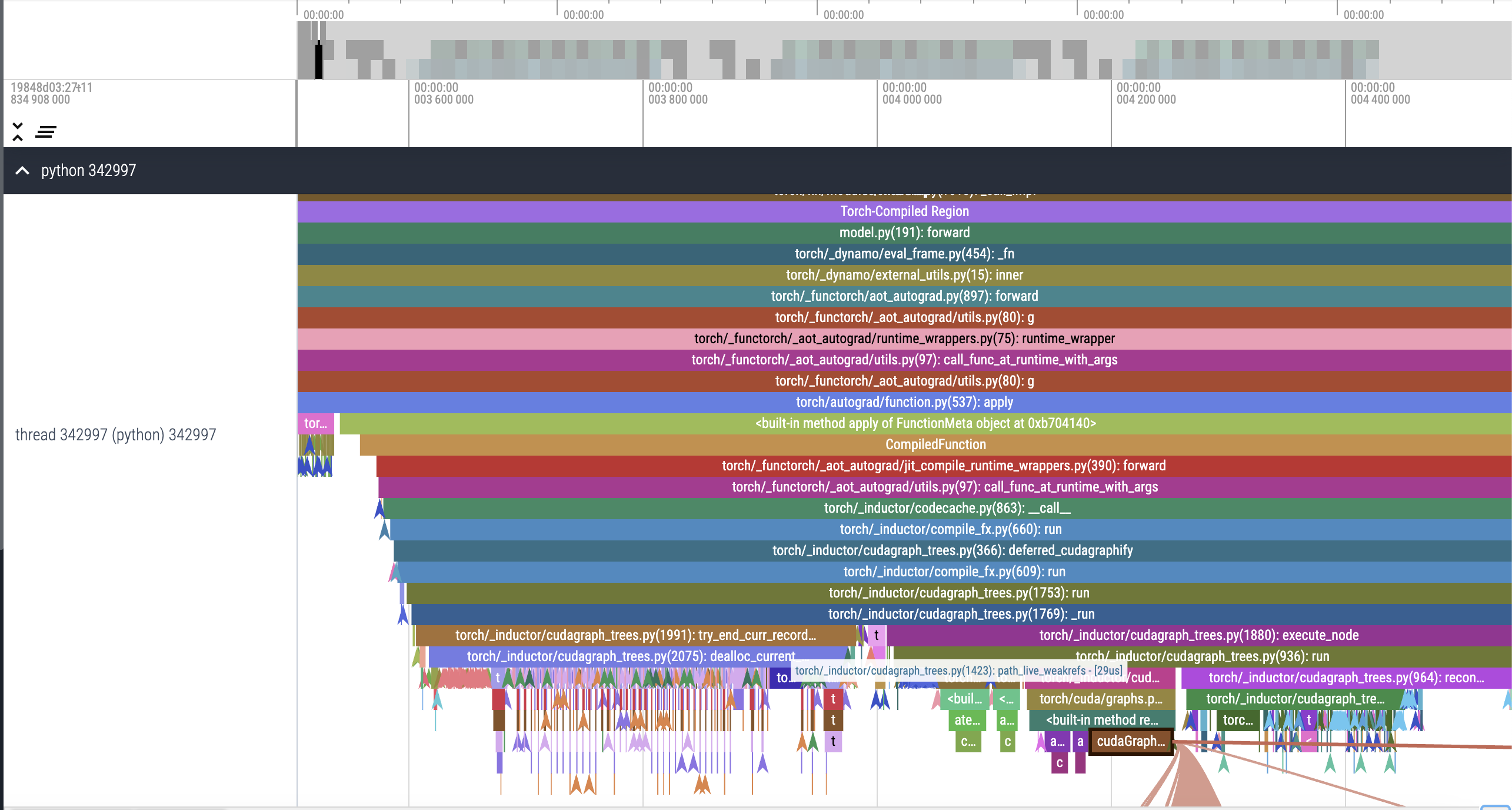


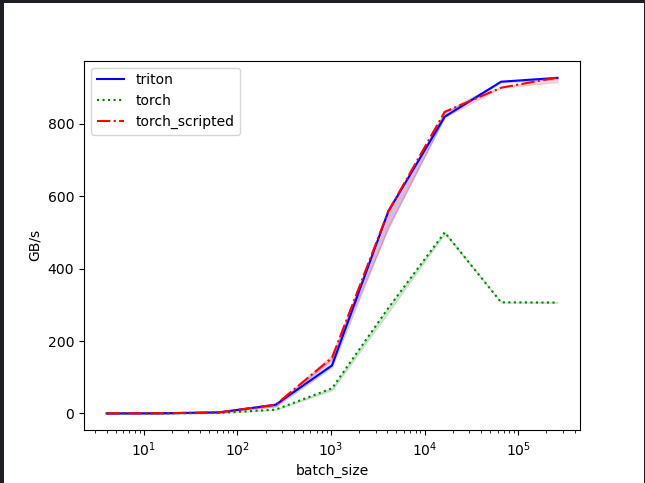
Comments powered by Disqus.